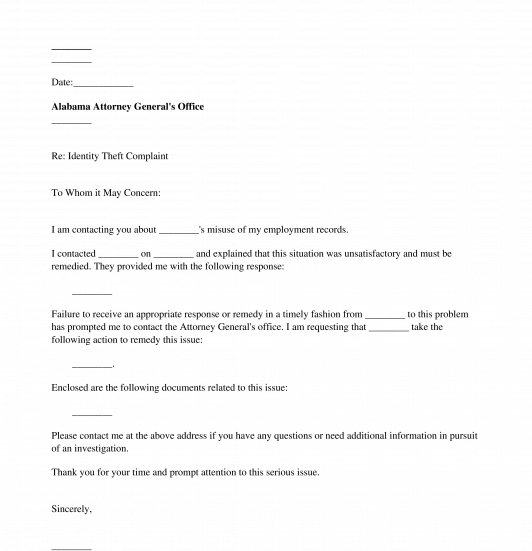 01/03/2025
01/03/2025

Answer a few questions and your document is created automatically.

Your document is ready! You will receive it in Word and PDF formats. You will be able to modify it.

 01/03/2025
01/03/2025
 Word and PDF
Word and PDF
 1 page
1 page



An Attorney General Identity Theft Complaint Letter is a document used by someone, known as the Reporter, to alert their state Attorney General's office that a company is contributing to identity theft by being careless with sensitive information. This allows the Attorney General's office to intervene, reprimand the company, and fix the issue for the Reporter and other consumers who may be affected by the issue. For example, some companies may have abusive direct marketing lists or practices or they may have not been careful in assuring that customer files do not fall into the hands of identity thieves. Using this letter helps the Attorney General prevent these issues from occurring in the future. When a person's identity has been stolen and used by the thief for tax fraud, the Reporter can also send a Notification of Fraudulent Tax Filing to the IRS so they can handle any fall out or tax consequences.
How to use this document
This document has all of the information necessary to alert the Attorney General's office to a company whose practices contribute to identity theft. The letter first gets information identifying both the Reporter and the company at fault. It then allows the Reporter to identify the reason for their complaint. The most common reasons are misuse of employment records, refusal to remove someone's name from a direct marketing list, and unauthorized sale of the Reporter's name and other information to a third party for marketing purposes. However, if the Reporter would like to make a different kind of complaint, they may do so by describing the specific reason for their complaint. The letter also allows the Reporter to explain the situation and describe company's response when alerted to the issue. The Reporter may also specify what actions they are asking the company to take in order to rectify the situation. Finally, the Reporter is given the option of describing any additional documents that may be enclosed with the letter, such as police reports or email correspondence.
Once the letter has been completed, the Reporter may print and sign the letter and then send it to their state Attorney General's office. Many states have several different mailing addresses for their Attorney General's office, so the Reporter should ensure they send it to the correct office.
Applicable law
Issues related to identity theft and privacy are governed by both state and federal law. One of the functions of state Attorney Generals is to protect consumers from unscrupulous businesses and their careless business practices. All states have an Attorney General appointed for this purpose and most of their offices have a specific unit devoted to consumer protection. Identity theft is a criminal act that will be investigated both on the local level by police departments, but also on a state or federal level by the state Attorney General's Office, Federal Trade Commission (FTC) and the Department of Justice (DOJ). Federally, the Identity Theft and Assumption Deterrence Act is the main legislation that protects individuals from identity theft and prosecutes those charged with stealing people's private identifying information.
How to modify the template
You fill out a form. The document is created before your eyes as you respond to the questions.
At the end, you receive it in Word and PDF formats. You can modify it and reuse it.
A guide to help you: How to Send a Letter
Attorney General Identity Theft Complaint Letter - FREE
Country: United States